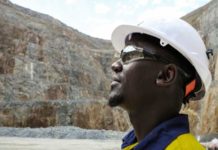
[miningmx.com] — PICTURE John McEnroe in terminal tantrum mode screaming “you cannot be serious” – that about sums up my reaction to the news that Shanduka Resources is looking at buying control of Messina Platinum Mines (Messina) from Lonmin.
Shanduka is, of course, Lonmin’s black economic empowerment partner following the deal last May in which it took control of Lonmin’s former BEE vehicle Incwala Resources.
Incwala had gotten into deep financial trouble for a number of reasons, including a decision by its management to invest in another Lonmin lemon – the Akanani underground project situated down-dip of Anglo American Platinum’s (Amplats) open cast Mogalakwena mine.
In July 2007 Incwala paid R800m for a 26% stake in Akanani which was being touted by then Lonmin CEO Brad Mills as a mine capable of producing up to 625,000 ounces of platinum group metals (PGM) annually.
Mills had bought Akanani in the first place because it slotted in with his mission in life which was to introduce mechanised mining methods to Lonmin.
That policy proved disastrous leading to a plunge in Lonmin’s output and the departure of a string of highly experienced executives. It was changed when current Lonmin CEO Ian Farmer took over from Mills in 2008.
In his first series of rectifying decisions, Farmer shut down the loss-making Messina mine and put the Akanani project on hold.
Farmer described Akanani in his 2010 review as an asset for profitable growth “beyond 2013′ along with Limpopo, Pandora and Marikana.
Farmer also said of the Shanduka/Incwala arrangement that “the objective of securing a new BEE partner via a robust funding structure is critical to the future of Lonmin”.
“Following an extensive process in this regard it has become clear that this objective can only be achieved with significant funding from Lonmin.”
CLAW BACK
Lonmin coughed up R2.5bn through a vendor loan finance package, while Shanduka only had to find R300m in cash from its side to seal the BEE deal.
So maybe Monday’s announcement that Shanduka could invest R1.1bn to buy 50% plus one share of Messina is some kind of sneaky claw back move by Lonmin?
Or maybe Shanduka simply has money burning a hole in its corporate pocket? After all, this year it cleaned up making a profit of around R2.3bn on the sale of its 11.8% stake in Assore.
But seriously folks, whereas Akanani remains an unknown quantity in that nobody has yet tried to mine it, Messina – aka Lonmin’s Limpopo division – has a long history of failed mining attempts by previous owners.
Those include Impala Platinum, Southern Era/Southern Platinum and, of course, Lonmin itself. So what precisely is it that Shanduka thinks it is going to do differently?
In reply to e-mailed questions a Shanduka spokesperson said “Limpopo will be Shanduka’s only operating PGM mine and will receive absolute focus.
“There will be minimal overheads with limited head office and shared service infrastructure. Shanduka is also likely to employ a contractor model, limiting the fixed cost overheads.”
As to why buy Limpopo in the first place the Shanduka spokesperson said “the existing mine infrastructure and substantial, relatively shallow reserve/resource base makes the asset very attractive, particularly when compared to other greenfields deep resources”.
The problem with Messina has always been its difficult mining conditions because of the complex and steeply-dipping nature of the PGM bearing reefs.
Even at the best of times the Messina mine has been one of the highest cost producers in the industry which leads to another point – this is not a good time to be looking at developing a new platinum mine.
The platinum price in dollars is falling and so are industry profit margins under assault from a string of cost issues such as labour, power and water while costs are also being driven up as mining operations go deeper.
Aquarius Platinum CEO Stuart Murray summed up the situation in this year’s Mining Yearbook saying, “this is a boom and bust industry. The cycles are getting shorter, the volatility is getting greater and it’s getting harder to get a decent return out of new investments”.
At least Aquarius’ BEE partner – the Savannah consortium – got in at the right time and profited handsomely from one of the most successful BEE deals done in the SA mining industry to date.
Incwala was not so fortunate and neither has been Anooraq Resources which is currently renegotiating the terms of its arrangement with Amplats over the Bokoni – formerly Lebowa Platinum – mine.
In fact, as part of their feasibility study on Messina, I would suggest Shanduka management have a long chat with former Anooraq Resources CEO Philip Kotze to get his views on what can go wrong.
Lebowa Platinum – like Messina – has always been near the top of the industry cost curve. Anooraq took over management from Amplats declaring they would be able to bring costs down to match industry norms.
It did not work out that way.











